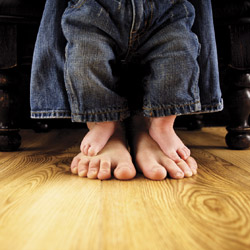Battling Bunions

Do you experience pain or soreness in your toes, especially while wearing shoes? Is the area on the side of your big toe inflamed and red? Are you prone to ingrown toenails, calluses or corns? If so, you may suffer from bunions.
A bunion is an irregular, bony enlargement that forms on the joint at the base of your big toe. This enlargement is actually the formation of additional bone, which causes the end of the big toe to bend toward and crowd the other toes. Bunions can cause pain due to inflammation and the bone pressing against your shoe.
Who’s at risk?
Bunions occur primarily in women; some studies report that women are 10 times more likely to suffer from bunions than men. Tight-fitting shoes, especially high heels or those with narrow toes, increase the risk of bunions because they force your toes into the front of your shoes, crowding them.
Other factors can put you at risk for developing bunions, including:
- bone deformities
- arthritis or gout
- heredity
- flat feet
- excessive pronation (an abnormal rolling inward of the foot while walking)
- an occupation that places stress on your feet, such as a dancer, athlete, waiter or factory worker.
Over time, these factors can change the toe’s position, causing misalignment, redness, tenderness and pain.
Symptoms
A bunion will begin as a bulging bump on the outside of the base of your big toe. You may experience swelling, redness and/or soreness, and the skin at the base of your toe may thicken. Corns or calluses may develop where the first and second toes overlap, and movement of your big toe may be restricted. The pain may range from mild to severe, and you may experience problems walking in normal shoes. The pressure of your big toe on your other toes may cause your toenails to grow into the sides of your nail beds. Those smaller toes may become bent or claw-like, a condition known as hammertoes.
Diagnosis and treatment
Though the fact that you have a bunion may be obvious, your physician will examine your foot and take x-rays to determine the status of your foot joints, and to help screen for an underlying cause such as arthritis or gout.
Treatment recommendations will depend on the severity of your condition. Conservative, non-surgical approaches include:
- Wearing comfortable shoes that offer more room for your toes, or using custom-molded padded shoe inserts (orthotics) to keep the foot properly aligned.
- Taping the toes and padding the foot in a normal position, reducing the stress on the bunion itself.
- Taking nonsteroidal anti-inflammatory drugs (NSAIDs) such as ibuprophen (Advil, Motrin) or naproxen (Aleve) to reduce pain and inflammation.
- Using warmth, such as a heating pad or whirlpool bath, to provide relief.
Eliminating bunions completely can only be accomplished by a surgical procedure called a bunionectomy. This procedure can be performed at a variety of levels depending on the severity of your bunions. The simplest procedure involves shaving the bunion and repairing the soft tissue in the big toe joint. For more painful bunions, the bones of the big toe may be surgically fractured and realigned, or a wedge-shaped piece of bone may be removed from the toe, decreasing its angle. If either of these procedures is performed, the bones are repositioned and stabilized. In addition, if there are ligaments that are too tight or too loose, they may need to be surgically adjusted. Recovery time is usually six to eight weeks, and you will utilize crutches, a walking cast or a wheelchair until you can bear weight on the foot.
Keeping bunions at bay
The most effective way to prevent bunions is to wear comfortable shoes that fit well. Choose shoes that don’t cramp your toes—ones that have wide toe boxes. Experts recommend a half-inch of space between the tip of your longest toe and the end of the shoe. Women should avoid high-heeled shoes as well as those with pointed toes.
Control early bunions with bunion pads, arch supports or custom-made supports (orthotics) placed just behind the big toe joint on the bottom of your foot. This redistributes your weight while you are walking and takes pressure off your big toe. Ask your health professional to help you choose the right kind of orthotics. Before investing in custom, prescription orthotics, you may want to try brand-name, over-the-counter orthotics. If you don’t see an improvement with these options, talk to your physician about the non-surgical and surgical options listed above.
Be kind to your feet
Even if you have a family history of bunions, or any of the risk factors, it’s still important to take care of your feet. Choose your shoes carefully. When shoe shopping, buy at the end of the day, when your feet are at their largest. Take a break from your shoes to relax your feet when you’re at home. Finally, if you see a bunion starting, take steps to correct it early. See your physician to learn which treatment option is right for you. iBi

